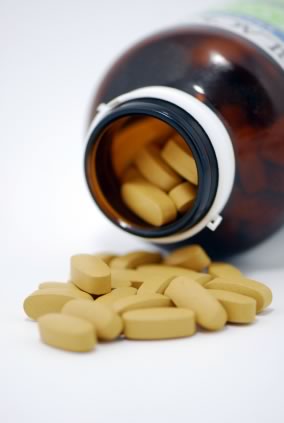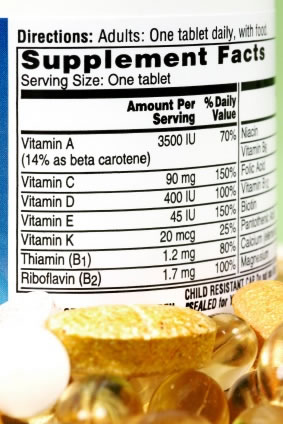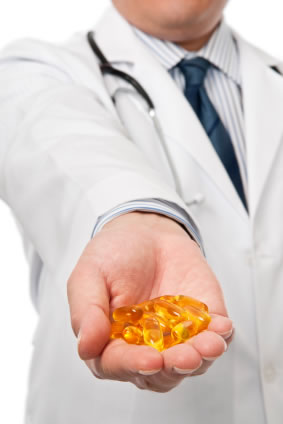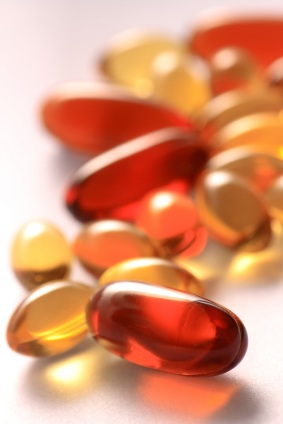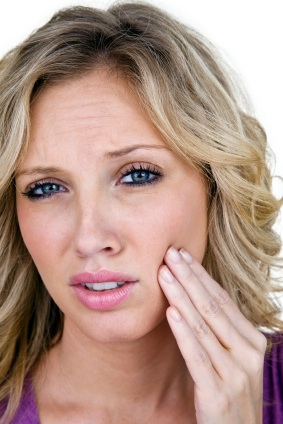Vitamin B6
Pyridoxine, Pyridoxal Phosphate, Pyridoxamine
Overview
Vitamin B6 is a part of the vitamin B complex group. The vitamin is water-soluble and is sometimes referred to as Pyridoxine. This vitamin aids in the metabolism of amino acids and the production of glucose from glycogen.
Though many of the vitamin B group members have properties that work against cancer, vitamin B6 has no known anti-cancer effects associated.
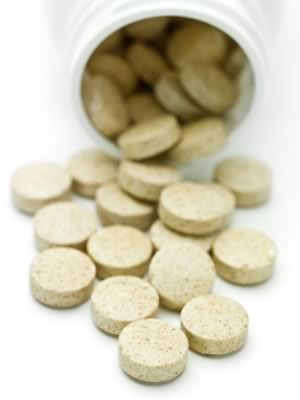
More studies must be conducted to conclude its effects. Some unofficial studies indicate vitamin B6 effectiveness in preventing colon cancer in healthy patients. However, more studies are necessary. Some experts indicate that vitamin B6 have been effective in treating patients with prostate cancer.
Recommended Daily Allowances (RDA)
Experts recommend consuming foods that allow individuals to meet their daily allowance without a supplement. Most people can meet their daily requirement for vitamin B6 without a supplement. Those who cannot meet the daily requirements should consider a supplement.
Experts recommend taking the vitamin after a meal and with copious amounts of water. Children who need a vitamin B6 supplement should consult with a physician prior to consumption.
The daily allowances of vitamin B6 vary by age groups. Experts recommend increasing vitamin B6 dosage as the person ages:
- Males: 14 to 18 years: 1.3 mg Average
- Females: 14 to 18 years: 1.2 mg Average
- 19 to 50 years: 1.3 mg
- Males: 51 years and older: 1.7 mg
- Females: 51 years and older: 1.5 mg
- Pregnant females: 1.9 mg
- Breastfeeding females: 2.0 mg
- Newborns: 0 to 6 months: 0.1 mg
- Infants: 7 months to 1 year: 0.3 mg
- Children: 1 to 3 years: 0.5 mg
- Children: 4 to 8 years: 0.6 mg
- Children: 9 to 13 years: 1 mg
To prevent heart disease or lower homocysteine levels, patients should consume 3.0 mg per day of vitamin B6. Physicians have in the past prescribed more to treat certain conditions. However, vitamin B6 should not be consumed in doses above 100 mg per day without a doctor’s supervision.
Sources of Vitamin B6
As mentioned earlier, experts recommend receiving the daily recommended allowance of food from natural food sources. Some of these sources may include the following foods:
- Chicken
- Tuna
- Turkey
- Salmon
- Shrimp
- Beef Liver
- Lentils
- Beans
- Sunflower Seeds
- Carrots
- Spinach
- Milk
- Cheese
- Brown Rice
- Bran
- Wheat Germ
- Whole-Grain Flour
For those who cannot meet the daily allowances, vitamin B6 can be found in supplements, such as multivitamins, and B complex vitamins. Adult vitamins may be found in the form of tablets, softgels and lozenges. Children’s supplements are often found in chewable tablets or liquid drops. Those seeking vitamin B6 supplements should also check for the names pyridoxamine, pyridoxal, pyridoxine hydrochloride, and pyridoxal-5-phosphate. Each name represents the vitamin B6 supplement.
History of Vitamin B6
Vitamin B6 was first discovered during a study in the 1930s. The study originated from scientists who were studying nutrition in rats. Paul Gyorgy, a Hungarian physician, first discovered vitamin B6 when he recognized that he could cure skin disease in rats with vitamin B6. Another scientist, Lepkovsky, isolated vitamin B6 from rice bran.
The structure of pyridoxine was demonstrated by Harris and Folkers in 1939. By 1945, scientist, Snell, was able to prove two separate structures of vitamin B6 existed. One of the structures was referred to as pyridoxal and the other pyridoxamine. After this discovery, vitamin B6 was referred to as pyridoxine to indicate its relationship to the structure pyridine. Each of the three forms of vitamin B6 paid a large role in the essential enzyme production within the body.
The enzymes promoted by vitamin B6 involve several amino acids. Scientists have documented over 140 activities related to the presence of vitamin B6 in the body.
Health Benefits
Several health benefits have been documented by scientists as it relates to vitamin B6. Some of the most common health benefits are listed below:
- Scientists have long speculated that vitamin B6 played a significant role in the treatment for Pre-Menstrual Syndrome (PMS), Pre-Menstrual Dysphoric Disorder (PMDD), and clinical depression.
- Some scientists have cited that vitamin B6 plays a significant role in the treatment for schizophrenia and autism.
- Studies have shown that vitamin B6 have increased the vividness of dreams and the ability to recall dreams. Scientists suspect that dream vividness is due in part to the conversion process of tryptophan to serotonin. Vitamin B6 is a component in this process.
- Some studies show that the consumption of vitamin B6 could reduce the risk of Parkinson’s disease by 50 percent. One such study was conducted in the Netherlands. However, the analysis showed that only smokers showed a decrease in the risk.
- Vitamin B6 or pyridoxine plays a significant role in heart disease prevention. Homocysteine levels rise when there is a pyridoxine deficiency. Studies have shown that elevated homocysteine levels may damage blood vessel linings and promote blood clots. When the body attempts to heal the blood vessel linings, it makes the person more vulnerable for plaque buildup and blood clots. Vitamin B6 prevents buildup and reduces the risk of heart attack.
- Pyridoxine or vitamin B6 lowers cholesterol levels and blood pressure. This keeps the blood platelets from coagulating to form a clot.
- Physicians often recommend a vitamin B6 supplement combined with magnesium to combat autism. This is a popular remedy in alternative medicine for this disease. Children develop autism before the age of three. This disorder affects the nervous system. Children suffering from the disorder often have difficulty with social interaction and communication.
- Some scientists indicate that vitamin B6 combined with magnesium can also alleviate the symptoms associated with attention deficit disorder (ADD). Studies have shown that the combination can improve hyperactivity, aggressiveness, and attention span in a classroom or work setting.
- Individuals who have a vitamin B6 deficiency may also experience sensitivity to monosodium glutamate (MSG). MSG is a popular flavor enhancer found in many Asian dishes. Some people report nausea, dizziness, vomiting, headaches, pain or tingling of upper extremities after consuming the Asian food containing MSG. Studies show an improvement in individuals who possessed a deficiency prior to consuming MSG.
- Individuals with a deficiency in vitamin B6 may be more susceptible to developing carpal tunnel syndrome. This may occur if the person is on minimally deficient in vitamin B6. Individuals who suffer from carpal tunnel syndrome may experience pain and tingling in the wrists after typing repetitively or other repetitive hand motion. Two studies have shown that vitamin B6 has been beneficial in treating carpal tunnel syndrome in patients who do not have significant trauma.
- Vitamin B6 has been recommended by physicians and scientists for relieving premenstrual syndrome (PMS). However, the data is inconclusive as to which symptoms are relieved by the intake of Vitamin B6. Some studies show that females who consume vitamin B6 have fewer symptoms of bloating, acne flares, and breast pain. Studies show strong evidence leaning towards the effects of vitamin B6 in acne flares that begin before and during a women’s menstrual cycle. The acne flares are a result of a hormone imbalance that occurs before and during a woman’s menstrual cycle. Approximately ten days before a woman’s menstrual cycle, vitamin B6 should be consumed to prevent acne break outs. The vitamin is thought to be effective because it regulates hormones and prostaglandin.
- Some experts cite that a deficiency of vitamin B6 may also lead to depression. Vitamin B6 or pyridoxine helps to produce serotonin and other neurotransmitters. After a vitamin B6 supplement, patients cite that their mood and their memory improve.
- Individuals suffering from morning sickness have cited that consumption of vitamin B6 alleviated some of the symptoms associated with this ailment. Experts speculate that this may be in part due to the fact that vitamin B6 may act as a diuretic.
- Other studies indicate that vitamin B6 may be effective in alleviating the effects of an alcoholic hangover as well. This is also due to the diuretic nature of vitamin B6. More studies should be conducted to prove this finding conclusively.
- Some experts suggest that vitamin B6 or pyridoxamine has been effective in treating diabetic nephropathy. Further studies should be done to prove this finding conclusively.
- Studies show that moderate intake of vitamin B6 may decrease the risk of colon cancer by half. More studies are necessary to prove the finding conclusively.
Ailments from Vitamin B6 Deficiencies
The benefits from vitamin B6 consumption are plentiful. Conversely, the lack of vitamin B6 may cause some undesirable conditions. Some of the most common deficiencies are listed below:
- Atrophic glossitis
- Angular cheilitis
- Intertrigo
- Conjunctivitis
- Seborrehoeic dermatitis
- Somnolence
- Confusion
- Neuropathy
- Rheumatoid arthritis
- Heart disease
- Depression
- Carpel tunnel syndrome
- Pre-menstrual syndrome
- Morning sickness
- Parkinson’s disease
This condition is referred to as smooth tongue. Experts have suggested that a tender or painful tongue may be the result of a vitamin B6 deficiency.
Angular cheilitis describes a lesion at the corner of the mouth that is usually characterized by cracks or splits. The lesion may also be inflamed. Scientists have come to believe that vitamin B6 deficiency may play a role in the development of this condition.
Intertrigo describes the rash or inflammation that occurs where the body folds. Areas such as, under the arms, under the breast and other places are affected. Vitamin B6 deficiencies may lead to this condition. More research is needed to prove this conclusively.
Conjunctivitis describes the inflammation of the eye. The condition often occurs because of an allergic reaction or an infection. The condition may be viral, but it is sometimes bacterial. Vitamin B6 deficiencies may also be the cause of this condition as well.
Seborrhoeic dermatitis may also be known as Seborreheic eczema. The condition affects sebum rich areas of the body, such as scalp, face and torso. The skin becomes scaly, flaky, itchy, and red as a result. These symptoms are characteristic of vitamin B6 deficiencies.
Somnolence is a strong desire for sleep for long periods of time. This chronic condition may be a result of a vitamin B6 deficiency.
When a vitamin B6 deficiency occurs in the body, individuals have reported states of confusion or loss of orientation. The person may forget their personal identity or be unable to locate themselves properly within the world.
Some of the most common neuropathic disorders are associated with diabetes mellitus. This occurs when there is an injury to the small blood vessels that supply nutrients to the nerves. Vitamin B6 deficiencies may be the cause of some of these common neuropathic disorders.
Individuals with rheumatoid arthritis often have low levels of vitamin B6. Some studies indicate that people with rheumatoid arthritis may need to consume more vitamin B6 than healthy people. This is due chronic inflammation problems associated with rheumatoid arthritis. Individuals suffering with rheumatoid arthritis should consult their doctor before taking any supplements.
Individuals who have deficiencies of vitamin B6 in their diets are at greater risk for heart disease. Individuals with high homocysteine levels associated with low levels of vitamin B6 may have damaged blood vessels and increased chances of blood clot formation.
Vitamin B6 deficiencies are often associated with depression. Serotonin levels affect a person’s mood. Experts suggest that vitamin B6 plays a role in the production of serotonin. Therefore, increased vitamin B6 intake may improve depression. More research is being conducted to determine its true benefit.
Experts have found that deficiencies in vitamin B6 may contribute to the symptoms of carpal tunnel syndrome. More studies should be performed to prove this finding conclusively.
Vitamin B6 deficiencies may be a factor in symptoms associated with PMS. Many of the studies conducted to prove that vitamin B6 deficiencies played a role PMS were not designed properly. Therefore, more research must be conducted to prove this finding conclusively. However, many female patients have remarked that vitamin B6 supplements have alleviated some of the symptoms and improved their moods. Consult a physician before beginning a vitamin B6 regimen. Improvements may take up to 3 months.
Several studies have been conducted to prove that vitamin B6 deficiencies may cause morning sickness. Pregnant women who consumed 30 mg of vitamin B6 daily found that the effects of morning sickness decreased. Pregnant women should consult with a physician before taking vitamin B6 supplements.
Some experts suggest that daily consumption of vitamin B6 may reduce the risk of Parkinson’s disease. This is thought to be true since the vitamin improves neurological functions. More studies are needed before this finding is conclusive.
Vitamin B6 deficiency is uncommon in individuals as a solitary deficiency. The deficiency is usually accompanied by another deficiency, such as another vitamin in the B complex. The elderly, most commonly, experience a vitamin B6 deficiency. Alcoholics may also experience a vitamin B6 deficiency. Renal patients undergoing dialysis may also experience vitamin B6 deficiencies.
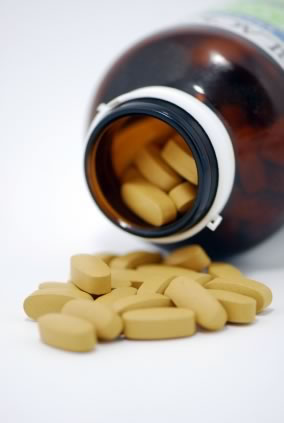
Patients consuming anticonvulsants or corticosteriods may experience a vitamin B6 deficiency, as well.
Severe vitamin B6 deficiencies may lead to damage to the nervous system and also to the skin. Less severe deficiencies due to an impaired tryptophan-niacin conversion may manifest as lesions to the skin.
Physicians can detect this impairment by testing the urine for xanthurenic acid. Vitamin B6 deficiencies may also occur from an impaired process of “transsulfuration of methionine to cysteine.”
Precautions when Taking Vitamin B6
Patients who are taking any of the following medications should consult a physician prior to starting a vitamin B6 regimen:
- Cycloserine or Seromycin: This medication is used to treat patients afflicted with tuberculosis.
- Hydralazine or Apresoline: This medication is used to treat patients with high blood pressure.
- Isoniazid: This medication is used to treat patients with tuberculosis.
- Penicillamine: This medication is used to treat rheumatoid arthritis.
- Theophylline or TheoDur: This medication is used to treat asthma.
Most of these medications may require a supplement because the medications deplete the system of vitamin B6. However, it is also always recommended to consult a physician to avoid complications or problems associated with vitamins.
Drug Interactions
Antibiotics: Vitamin B6 vitamins have been known to interfere with the absorption of the antibiotic tetracycline. The timing of the vitamins and antibiotics should be spaced out in order to avoid unpleasant interactions.
Antidepressant Medications: Experts recommend taking vitamin B6 to boost the effectiveness of antidepressants. Some antidepressants that benefit from vitamin B6 are as follows:
- Nortriptyline or Pamelor
- Amitriptyline or Elavil
- Desipramine or Norpramin
- Imipramine or Tofranil
- Monoamine Oxidase Inhibitors (MAOIs), such as Phenelzine (Nardil) or tranylcypromine (Parnate)
Chemotherapy drugs: Vitamin B6 may reduce some of the side effects associated with chemotherapy drugs, such as 5-fluorouracil and doxorubicin. Consult a physician before taking a vitamin B6 supplement.
Erythropoietin (EPO): Erythropoitin therapy may deplete vitamin B6 levels present in the body. Therefore, some people may need a supplement in order to replenish vitamin deficiency.
Levodopa: This medication is used to treat Parkinson’s disease. Experts suggest that vitamin B6 reduces the effectiveness of levodopa. A physician should determine the dosage of vitamin B6 that is required to avoid interaction with the drug. A physician should closely monitor the consumption of both drugs in combination.
Phenytion or Dilantin: Patients who take phenytoin for seizures may notice that the drug is slightly less effective if taken with vitamin B6. Patients should consult a physician prior to taking the drugs in conjunction.
Role in Biological Process
Vitamin B6 or pyridoxal phosphate is involved in several biological processes. Pyridoxal phosphate is involved in neurotransmitter synthesis, histamine synthesis, macronutrient metabolism, gene expression and hemoglobin synthesis. This metabolically active form of vitamin B6 acts as a coenzyme to help facilitate transamination, racemization, decarboxylation, elimination, replacement, and beta-group interconversion reaction. Vitamin B6 is metabolized in the liver.
Amino Acid Metabolism
Pyridoxal phosphate (PLP) plays a significant role in the metabolism of amino acids. This vitamin assists two enzymes as methionine is converted to cysteine via two separate reactions. When there is a vitamin B6 deficiency, there is decreased activity related to these enzymes. Pyridoxal phosphate is also responsible for assisting the enzymes found in the metabolism of selenomethionine to selenohomocysteine.
Selenohomocysteine is converted to hydrogen selenide. Vitamin B6 is also involved in the process of converting tryptophan to niacin. The conversion process will be impaired if vitamin B6 status is low. Vitamin B6 is also responsible for the conversion of the following amino acids:
- Tryptophan to Serotonin
- Histindine to Histamine
- Glutamate to GABA (gamma-aminobutyric acid)
- Dihydroxyphenylalanine to Dopamine
Gluconeogenesis
Pyridoxal phosphate is necessary for the gluconeogenesis process. The vitamin catalyzes transamination reactions. Vitamin B6 also acts as a coenzyme in the glycognenolysis process. The coenzyme is necessary for glycogen phosphorylase.
Lipid Metabolism
Vitamin B6 plays an important role in the biosynthesis of sphingolipids. This process is dependent upon vitamin B6 because one of the enzymes, S1P Lyase needs the vitamin to complete the process.
In most processes, vitamin B6 assumes the role of a coenzyme to other enzymes in the body in the metabolism process. Vitamin B6 is found in the following processes:
- Gene Expression
- Neurotransmitter Synthesis
- Histamine Synthesis
- Amino acid, lipid and glucose metabolism
- Hemoglobin synthesis and function
Gene Expression
This process is responsible for transforming homocysteine into cysteine. The interim process involves changing cistation into cysteine. Pyridoxal phosphate plays a role in the gene expression process by increasing or decreasing the expression of genes present. A deficiency of vitamin B6 will lead to an increased expression of albumin mRNA.
Neurotransmitter Synthesis
Pyridoxal phosphate dependent enzymes are responsible for the biosynthesis of several neurotransmitters. The neurotransmitters include the following:
- Serotonin
- Epinephrine
- Norpinephrine
- Gamma-aminobutyric Acid
Histamine Synthesis
Pyridoxal phosphate or vitamin B6 is often involved in the metabolism of histamine.
Hemoglobin Synthesis and Function
The synthesis of hemoglobin is facilitated by pyridoxal phosphate. Vitamin B6 can bind on two sites present on hemoglobin. This process facilitates the binding of oxygen to hemoglobin.

